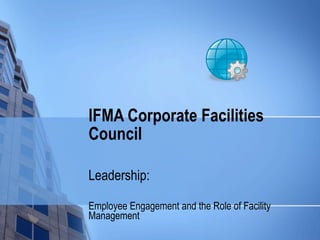Leadership Presentation
- 1. IFMA Corporate Facilities Council Leadership: Employee Engagement and the Role of Facility Management
- 2. Learning Objectives ŌĆō Understand: Define Leadership Explore Characteristics of Effective Leaders Explore Characteristics of Effective Leadership
- 3. Agenda: What is Engagement What is Leadership Putting it to Work
- 4. Education: Tim Parker Doctoral Candidate, Business Administration (DBA) Organizational Leadership ( Northcentral University, expected 2012 ) MS, Business Administration (Boston University) BS, Electrical Engineering (Virginia Military Institute)
- 5. Training: Quality Improvement Training (TQM) Baldrige Criteria Training Management of Environmental, Health and Safety Certificate (NC State University) Energy Management Diploma (NC State University)
- 6. Experience: United States Air Force 24 Years, Retired Lt Col Command of Air Base Support (1200 Staff) Engineering Organizations International Organizations (NATO, UN) Special Assignments US/USSR Arms Reduction Treaty Deputy Program Manager
- 8. Experience: Engineering Firm (Program Director) State Government (Director) Research and Development Non-profit (Director) Global Corporate Services Company
- 9. Experience: IFMA World Workplace International Conferences, 2006, 2007, 2009 NC American Society of Civil Engineers (ASCE)
- 10. Special Awards: US Secretary of Defense Superior Program Management Award, 1989 Intermediate-range Nuclear Forces (INF) Treaty, On-site Technical Inspection Utility Saving Initiative Energy Award North Carolina GovernorŌĆÖs Award for 2004 (2005, 2006)
- 11. Understanding Employee Engagement What is it? Employee attitude towards employer Drives ŌĆ£organizational commitmentŌĆØ Drives ŌĆ£job satisfactionŌĆØ
- 12. Understanding Employee Engagement What is the impact/effect? Voluntary discretionary effort Level of Resistance Absenteeism and Turnover
- 13. Understanding Employee Engagement What Affects Employee Engagement? Level of Expressed Care Dependent on ŌĆ£UnwrittenŌĆØ Mental Contract Expectations Meeting Promises Influence from ŌĆ£valueŌĆØ groups
- 14. Understanding Employee Engagement What is Your Part as Facility Manager Facilities and Services Know Your Audience Multiple Generations of Workers Therefore Different Expectations Realize You are Extension of Management Leadership Top Factor in Engagement No Single Way to Lead
- 15. Understanding Leadership How do you know you have it if you donŌĆÖt know what it is? Definitions? Influence (John Maxwell) Obtaining Followers (Peter Drucker) Power
- 16. Understanding Leadership You have achieved excellence as a leader when people will follow you everywhere if only out of curiosity ŌĆō Colin Powell If you have to tell them you are a lady, you probably arenŌĆÖt ŌĆō Margaret Thatcher
- 17. Understanding Leadership The very essence of all power to influence lies in getting the other person to participate ŌĆō Harry A. Overstreet The art of getting someone else to do something you want done because he wants to do it ŌĆō Dwight D. Eisenhower
- 18. Performance = f ( A X M X O ) A = Ability M = Motivation O = Opportunity ŌĆ£ Ability is what you're capable of doing. Motivation determines what you do. Attitude determines how well you do it.ŌĆØ - Lou Holtz
- 19. Understanding Leadership Schools of Thought ŌĆō Transactional vs Transformational Charismatic, Born Leader Traits Contingency Theory, X or Y Knowledge Workers vs Skilled Labor
- 20. Leadership Framework IQ or EQ (Emotional/Social Intelligence) - Awareness of Self Behavior Awareness of Impact on Others (Social) Positive Social Environment Mood Influences Effectiveness (ŌĆ£Primal LeadershipŌĆØ ŌĆō Goleman, Boyatis, McKee)
- 21. Leadership Framework IQ or EQ (Emotional/Social Intelligence) - Contribution 80-90 % of Competencies of Outstanding Leaders vs Average Self Mgmt Skills ŌĆō 78% More Incremental Profit Social Skills ŌĆō 110% More Both ŌĆō 390% More (ŌĆ£Primal LeadershipŌĆØ ŌĆō Goleman, Boyatis, McKee)
- 22. Leadership Framework Styles - Democratic + Affiliative + Coaching ++ Visionary ++ Pacesetter ? Command ? (ŌĆ£Primal LeadershipŌĆØ ŌĆō Goleman, Boyatis, McKee)
- 24. Putting it to Work Clarity is Key (WhatŌĆÖs the Vision) Ethics Build Organizational Capacity Train, Coach, Mentor, Invest Tools Openness/Transparent Trust & Integrity
- 25. Putting it to Work Delegate Well (Like Project Management) Empowerment? Spend Time with Staff (top 20%) Set the Example Work-family Balance, Education, Fitness, etc Sense of Urgency (vs Panic or Activity) Manage Time (Urgent/Important)
- 26. Putting it to Work Too Much Value Winning Too Much Negativity (Okay but, no, however, etc) Withhold Information Too much ŌĆ£meŌĆØ (ŌĆ£What Got You Here WonŌĆÖt Get You ThereŌĆØ - Marshall Goldsmith, Mark Reiter)
- 27. Putting it to Work Recognize Achievement (Theirs) Give Credit Away In Group, Out Group Listen Appreciation (For Everyday Activities) (ŌĆ£What Got You Here WonŌĆÖt Get You ThereŌĆØ - Marshall Goldsmith, Mark Reiter)
- 28. Putting it to Work Goal Fixation (ŌĆ£What Got You Here WonŌĆÖt Get You ThereŌĆØ - Marshall Goldsmith, Mark Reiter)
- 30. Benefits and Value Increased Organizational Commitment More Productive Teams Talented Leadership Increased Collaboration Increased Project Management Skills Effective Use of Technical and Professional Talent
- 31. Leadership for FM Understand Leadership Styles: Emotional/Social Intelligence. Practical Stuff
- 32. Leadership for Engineers - Experience United States Air Force
- 33. Leadership for FM Tim Parker [email_address] www.linkedin.com/in/timparker75

































![Leadership for FM Tim Parker [email_address] www.linkedin.com/in/timparker75](https://image.slidesharecdn.com/ifmacfcpresentationaug2011-13148920628512-phpapp02-110901105126-phpapp02/85/Leadership-Presentation-33-320.jpg)